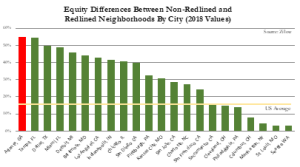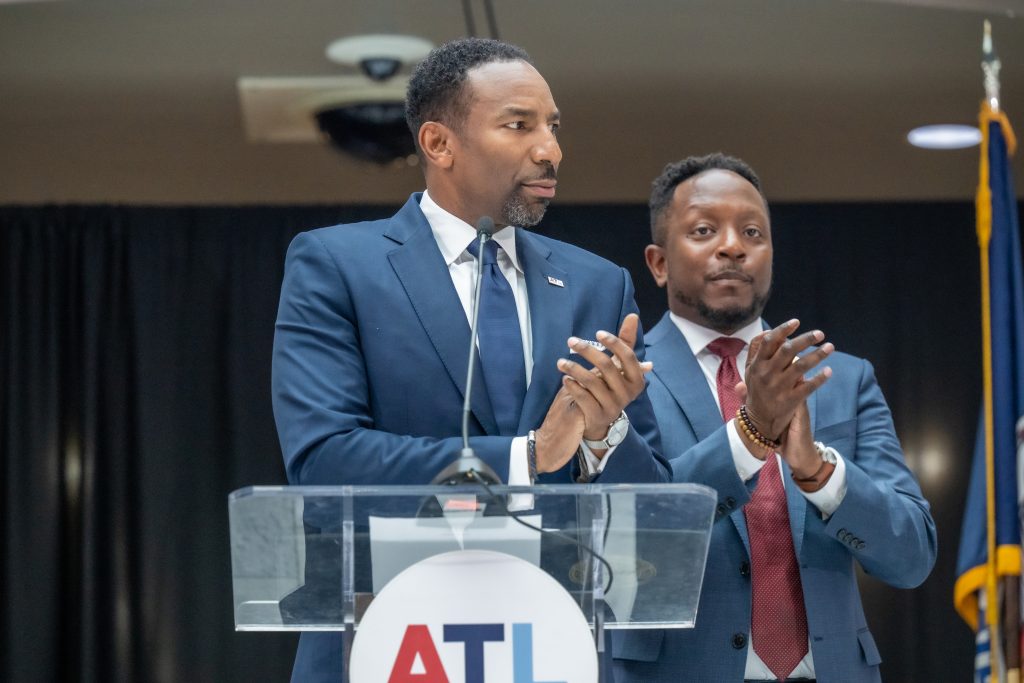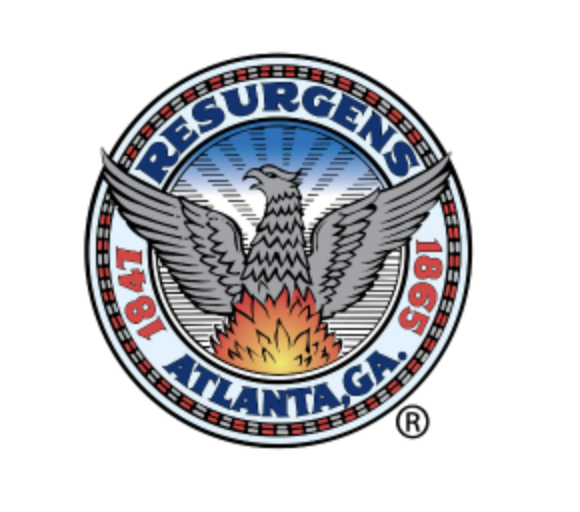On the last day of September 2025, Mayor Andre Dickens walked to a podium and announced an investment that could define Atlanta’s future. Its name is the Neighborhood Reinvestment Initiative, or NRI, but its ambition is grander than any acronym suggests. The Mayor framed it simply: this is Atlanta’s strategy for becoming the best city in America to raise a child.
Children cannot succeed unless they grow up in thriving neighborhoods – places where the air is breathable, the schools perform, the parks are welcoming, and the streets are safe. All of the outcomes that concern us – failing schools, health disparities, crime and violence, and the lack of economic mobility – all share the same root cause: children growing up in distressed neighborhoods. The NRI is an attempt to eradicate those root causes by returning distressed neighborhoods to health through a set of tailored investments in housing, education, health & recreation, economic development, and transportation. This is not a small-bore pilot, not a one-off project in a single community. It is a citywide attempt, the largest ever undertaken in America, to prove that geography is not destiny and where opportunity is not defined by zip code.
It is a bet against Atlanta’s most enduring story: the tale of two cities.
The Tale Beneath the Skyline
Atlanta thinks of itself as a beacon of progress. This was the cradle of the civil rights movement, the birthplace of Martin Luther King Jr., and the site of those famous black-and-white photographs where ministers marched in their Sunday suits toward justice. To visitors flying in, the skyline gleams with cranes and towers, a testament to growth and prosperity and the enduring promise of the New South. But peel back the veneer and you see a different reality – the persistence of one of the most segregated and inequitable cities in America.
Drive north or east and you encounter leafy, prosperous neighborhoods that are almost entirely White. Drive south or west and you enter struggling, distressed neighborhoods that are almost entirely Black. Out of Atlanta’s ten traditional public high schools, seven do not enroll a single White student. Atlanta remains stubbornly partitioned.
 That partition is not an accident of preference but a residue of deliberate policy. In 1922, Atlanta adopted a zoning ordinance dividing the city into an “R-1 White district” and an “R-2 colored district.” The Planning Director argued openly that neighborhoods must be “protected” from the “encroachment of the colored race.” Even when the Georgia Supreme Court struck down the statute, public and private practices ensured the spirit lived on. In the 1930s, the Federal Housing Administration adopted the policy of “redlining” which restricted access to home financing in predominantly Black neighborhoods. As late as 1962, a barricade was erected across Peyton Road to keep Black families from “intruding” on adjoining White blocks. It stood for 72 days before a court forced its removal. Then came White flight: Federal policies incentivized suburban mortgages and new highways facilitated the escape. During the 1960s Atlanta’s White population shrank by more than 60,000.
That partition is not an accident of preference but a residue of deliberate policy. In 1922, Atlanta adopted a zoning ordinance dividing the city into an “R-1 White district” and an “R-2 colored district.” The Planning Director argued openly that neighborhoods must be “protected” from the “encroachment of the colored race.” Even when the Georgia Supreme Court struck down the statute, public and private practices ensured the spirit lived on. In the 1930s, the Federal Housing Administration adopted the policy of “redlining” which restricted access to home financing in predominantly Black neighborhoods. As late as 1962, a barricade was erected across Peyton Road to keep Black families from “intruding” on adjoining White blocks. It stood for 72 days before a court forced its removal. Then came White flight: Federal policies incentivized suburban mortgages and new highways facilitated the escape. During the 1960s Atlanta’s White population shrank by more than 60,000.
Wealth Built in Brick and Land
The map of Atlanta today is the story of America told in miniature: how a century of laws, deeds, covenants, barricades, and subsidies created a geography of opportunity for some and a geography of exclusion for others.
Nothing demonstrates this split more starkly than wealth. The median White household in Atlanta holds $238,000 in wealth; the median Black household holds $5,000. That forty-six-to-one ratio is nearly four times the national average. Imagine the psychic toll of that: to walk the same city streets, share the same weather, but live in worlds so financially apart they may as well be parallel universes.
 This wealth gap is mostly driven by property values. The average home value in previously redlined neighborhoods is $293,000. In non-redlined neighborhoods it is $429,000. That $235,000 difference almost perfectly mirrors the national wealth gap between Black and White households. No city in America has seen a larger divergence in residential equity growth between redlined and non-redlined areas than Atlanta.
This wealth gap is mostly driven by property values. The average home value in previously redlined neighborhoods is $293,000. In non-redlined neighborhoods it is $429,000. That $235,000 difference almost perfectly mirrors the national wealth gap between Black and White households. No city in America has seen a larger divergence in residential equity growth between redlined and non-redlined areas than Atlanta.
Consider the boom of the past decade. Between 2011 and 2023, the appraised value of Atlanta’s property digest more than doubled, from $62 billion to $136 billion. Yet 84% of that increase accrued to the neighborhoods on the north and east sides of the city. Since real estate equity constitutes two-thirds of household wealth, an entire generation of Black property owners have missed out on perhaps the most substantial wealth-building opportunity in Atlanta’s history.
Schools as Neighborhood Thermometers
These disparities are not abstract; they surface every morning when children walk into school. Atlanta has thirty elementary schools where fewer than one in four fourth-graders meet state standards in English and Language Arts. Every one of those schools serves the west and south sides.
 Look closer, and you see a nearly perfect correlation between school performance and neighborhood conditions. The scatterplots are haunting: no schools appear in the quadrant of poor neighborhoods with high test scores, or rich neighborhoods with low ones. What this suggests is sobering: a school cannot “great-principal” its way to excellence or “bad-principal” its way to failure. The driver is the condition of the neighborhood itself – the housing stability, the health stressors, access to fresh food and the safety of the streets.
Look closer, and you see a nearly perfect correlation between school performance and neighborhood conditions. The scatterplots are haunting: no schools appear in the quadrant of poor neighborhoods with high test scores, or rich neighborhoods with low ones. What this suggests is sobering: a school cannot “great-principal” its way to excellence or “bad-principal” its way to failure. The driver is the condition of the neighborhood itself – the housing stability, the health stressors, access to fresh food and the safety of the streets.
This means something profound. A school is not an independent institution floating in civic ether. It is a thermometer measuring the surrounding neighborhood’s temperature. Expecting a school to outperform its neighborhood is neither reasonable nor sustainable. If you want to improve education outcomes, you cannot simply train teachers or tinker with pedagogy. You must improve the neighborhoods children inhabit.
The Weight of Place
Social scientists call these place-based influences “neighborhood effects.” It is a dry phrase for something that in real lives feels suffocating. A child born into a distressed neighborhood experiences compounded stressors: more asthma, more trauma, more noise, more violence, fewer healthy food options, fewer parks, more mobility disruptions, and less wealth to cushion emergencies. These stressors accumulate in the body and the mind. They show up in grades, in ER visits, in police reports, and in truncated lifespans: a child born in Atlanta’s western and southern neighborhoods is likely to live up to 20 fewer years than one born on the north or east side.
The data is relentless: place matters. But here’s the catch – our public debates generally ignore geography. We rarely stare straight at the stubborn fact that outcomes cluster in neighborhoods, that social determinants are spatial, and that the laundry list of interventions that have been funded and implemented over the past 50 years have generated almost no impact on the outcomes that concern us. The Dickens Administration is saying that if we want durable change, we must change place.
The NRI: A Bet on Places
The Neighborhood Reinvestment Initiative begins from a conviction: our inequities are not random accidents but the results of mal-intended policy and accumulated disinvestment in very specific places. They can only be reversed by deliberate reinvestment in those places.
The NRI is designed to catalyze investment in disinvested neighborhoods such that the existing vicious cycle of disinvestment is reversed and becomes a virtual cycle of investment. The target neighborhoods are distressed but have assets that can leveraged and are geographically distributed so that their revival spills outward to adjacent neighborhoods. Since no two neighborhoods share the same history, assets, and vision for themselves, each plan is tailored to the expressed desires of their residents.
The plans included investments in housing, education, health, recreation, economic development, and transportation. Many of these projects have been on paper for years, already approved by the neighborhoods through planning exercises but stalled for lack of follow-through. In the Mayor’s telling, the city is simply keeping its promises, but this time with funding muscle.
Examples abound. In Grove Park, the city is developing the abandoned Gun Club property into 400 units of mixed-income housing and a new recreational center. In Thomasville, nearly 1,000 units of housing and much needed neighborhood-serving retail will rise. In West Hollowell, the Bowen Homes redevelopment will deliver 2,800 new housing units, a new early learning center, a new health center and trail connections, breathing life into a neighborhood that has lost population for decades.
But physical capital is not enough. The NRI emphasizes civic infrastructure. Neighborhood Partnership Organizations that give residents agency and protect accessibility have been identified or are being established. The West Hollowell Foundation is one such example, representing residents of Carey Park and Almond Park.
Any city-wide initiative focused on improving neighborhood conditions must protect and expand accessibility to those neighborhoods. The NRI includes programs that reduce the tax burden on legacy residents, help homeowners clean up tangled property deeds, and ensure that existing homes are in good repair. And the Mayor’s efforts to protect or add 20,000 units of affordable housing are being focused in these target neighborhoods to ensure a wide path of future accessibility for low-income residents. In short, the NRI is not just about building new places, but about ensuring current residents can stay and thrive.
Our Reckoning
There is no more important or urgent issue facing Atlanta than the persistence of equity gaps. Every metric that concerns us – failing schools, crime, health disparities, stagnant economic mobility – is rooted in neighborhood inequities. The Mayor argues that Atlanta cannot afford not to act, yet this will not succeed by mayoral fiat alone: the City needs the Atlanta Public Schools and Fulton County to extend their participation in Tax Allocation Districts. Bear in mind, the NRI is the most effective path to improve education, health and public safety outcomes, the very same outcomes APS and Fulton County are committed to delivering. Participation in the TADs does not “redirect” resources away from those agencies. Quite the contrary: funding the NRI is the most efficient and enduring means for them to advance their respective core missions. It is therefore in their interest for the NRI to succeed.
The challenge is immense, but Atlanta has done hard things before. This is a city that rebuilt after being burned in the Civil War. A city that birthed a civil rights movement. A city that reinvented itself through Olympic aspirations. The idea that Atlanta might be the first American city to erase the tale of two cities and replace it with a story of one – that is worthy of another reinvention.
The NRI is thus more than policy. It is a recognition that wealth is not only earned but inherited, not only the product of hard work but of accumulated advantage. It is an argument that urban life, at its best, is about creating common spaces where human flourishing is possible for all children, not just those lucky enough to be born in certain zip codes.
We have a choice. We can continue to spend our tax and philanthropic dollars trying to address our problems downstream or we can invest upstream by creating the conditions that children need thrive. As Frederick Douglass once said, “It’s easier to build strong children than repair broken men.”
The NRI offers Atlanta a chance to be the first city in America to prove that a place once segregated and scarred can be deliberately healed, that neighborhoods can be transformed not by accident or gentrification, but by intention and with equity. No city in the country has successfully managed such a feat. Atlanta can and should be the first.






